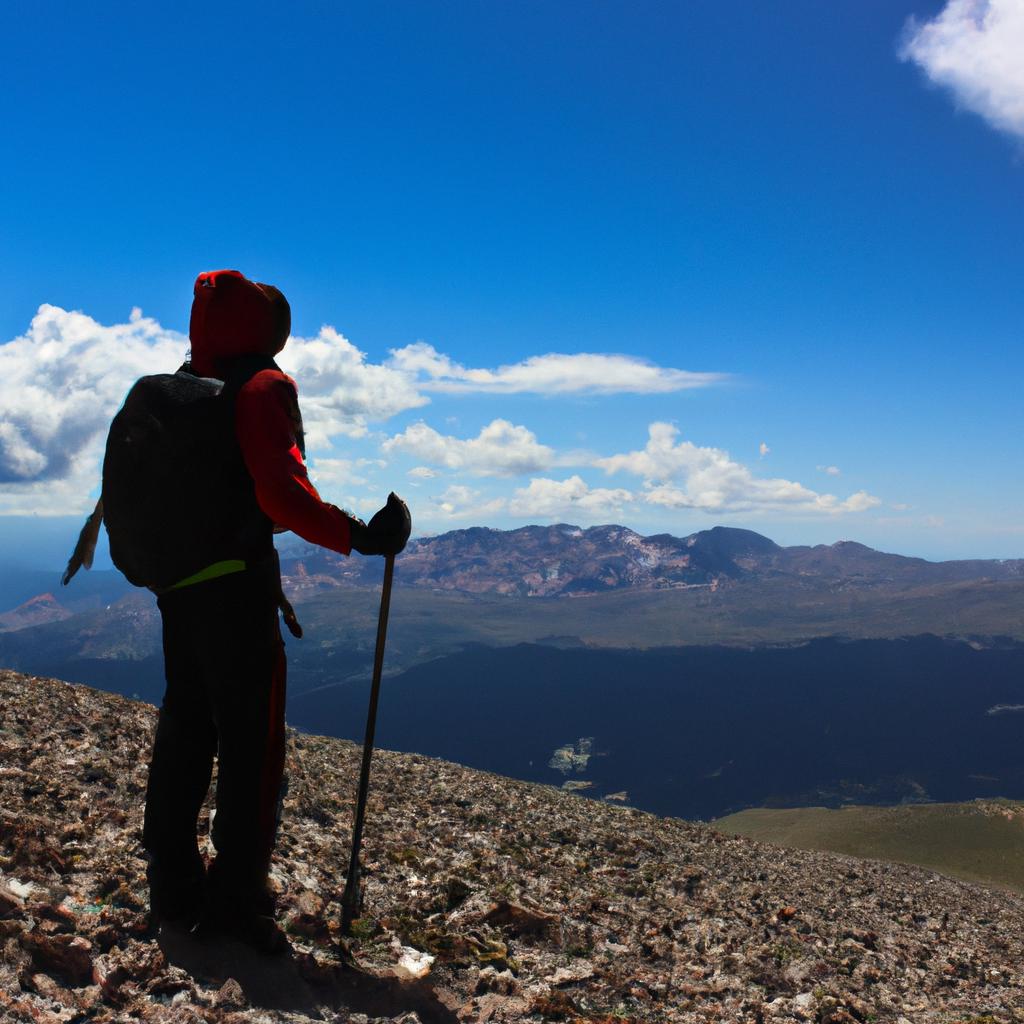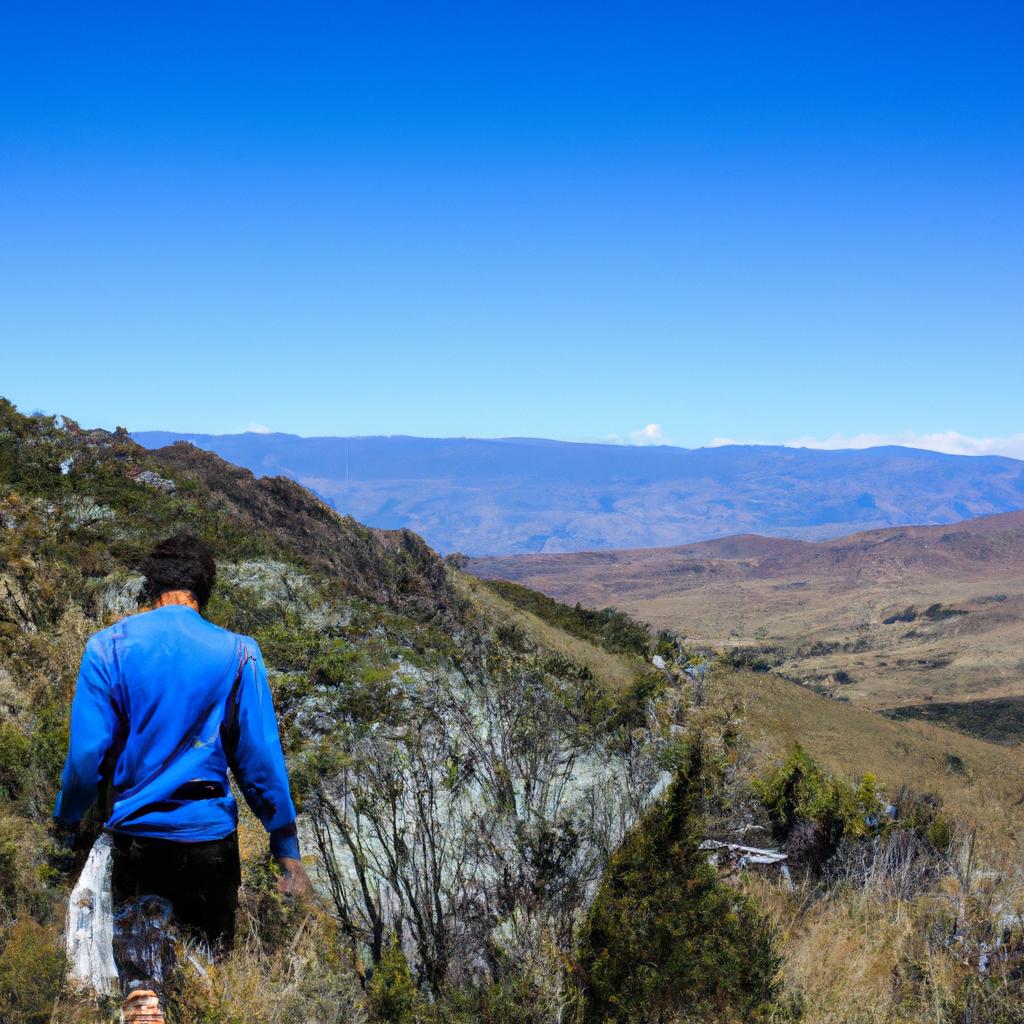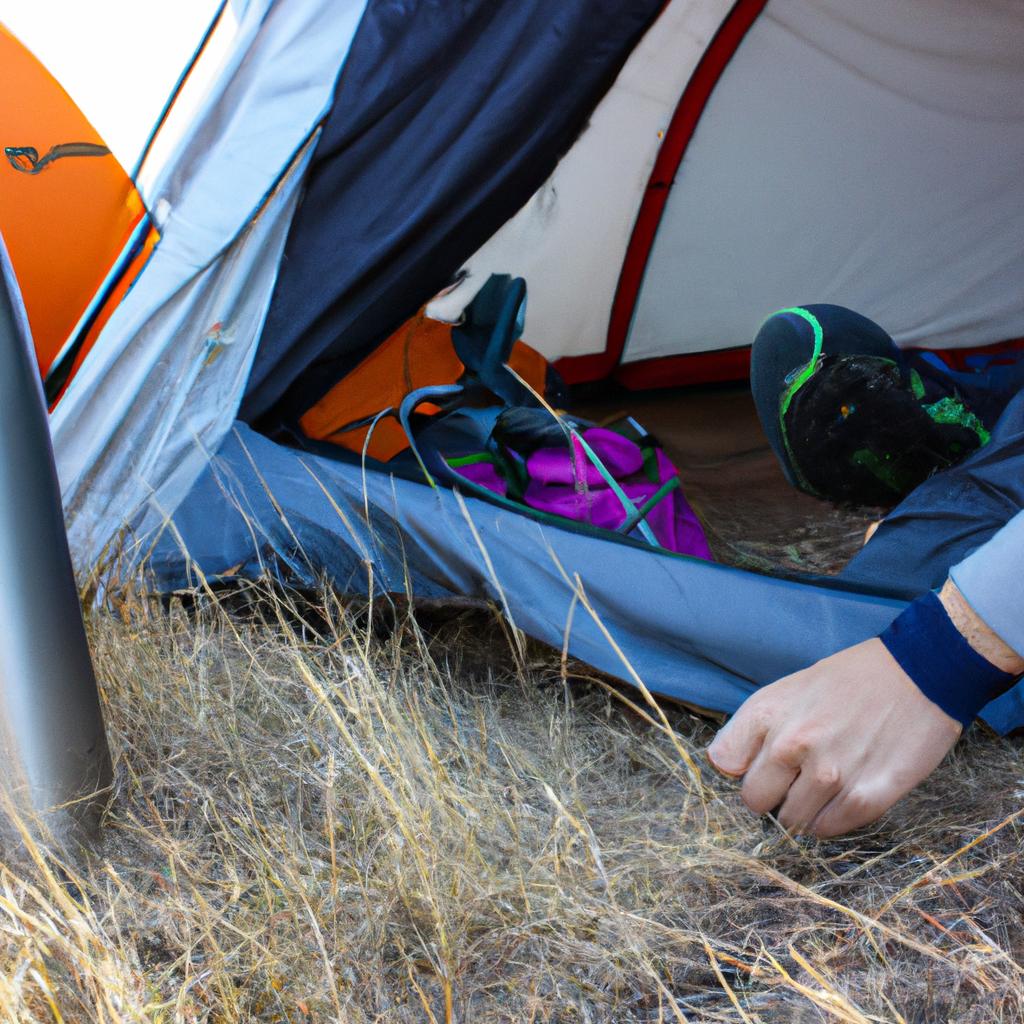Backpacking, a form of recreational travel that combines hiking and camping, offers individuals the opportunity to explore new terrains while immersing themselves in nature. Whether venturing into the wilderness or embarking on long-distance treks, backpacking enthusiasts must equip themselves with essential knowledge and skills to ensure their safety and success. This article presents a comprehensive guide on backpacking tips, aiming to provide readers with valuable insights and practical advice for an enjoyable and fulfilling experience.
Consider the case of Sarah, an avid backpacker who recently embarked on a solo expedition through remote mountain ranges. Equipped with her trusted gear, Sarah set out to conquer challenging trails and discover breathtaking landscapes. However, lacking sufficient preparation proved detrimental as she encountered unexpected challenges along the way. From inclement weather conditions to navigational difficulties, Sarah quickly realized the importance of acquiring adequate information before setting foot on any trail. To prevent others from experiencing similar setbacks, this article emphasizes the significance of thorough planning and preparedness when engaging in backpacking activities.
Choosing the Right Gear
When embarking on a backpacking trip, selecting the appropriate gear is crucial for ensuring a safe and enjoyable experience. The right equipment can make all the difference in terms of comfort, convenience, and overall success of your journey. To illustrate this point, consider the case study of Sarah, an avid hiker who recently went on a multi-day trek through rugged terrain without proper gear. Despite her enthusiasm and physical fitness, she encountered numerous challenges along the way due to inadequate preparation.
One essential aspect to consider when choosing gear is its suitability for the specific environment you will be traversing. For example, if you are planning to hike in cold weather conditions or at high altitudes, it is important to invest in quality insulation layers and thermal sleeping bags that can withstand low temperatures. On the other hand, if you anticipate hiking in hot and humid climates, lightweight and breathable clothing materials would be more suitable.
In addition to considering environmental factors, it is also vital to prioritize durability and functionality when selecting your gear. Backpacks with strong frames and reinforced stitching offer better support during long hikes while providing ample storage space for essentials such as food, water, and camping equipment. Similarly, durable tents made from waterproof materials protect against unexpected rain showers or inclement weather conditions.
To further emphasize the significance of choosing the right gear for backpacking trips, here is a bullet point list showcasing some benefits:
- Increased comfort: Properly fitted boots reduce blisters and foot pain.
- Enhanced safety: High-quality GPS devices provide accurate navigation.
- Improved efficiency: Lightweight cooking utensils decrease pack weight.
- Elevated enjoyment: Comfortable sleeping pads promote restful nights under starry skies.
Furthermore, let’s explore these advantages using a table format:
| Benefit | Example |
|---|---|
| Increased comfort | Well-padded backpack straps |
| Enhanced safety | Reliable headlamps |
| Improved efficiency | Efficient water filters |
| Elevated enjoyment | Cozy campfire chairs |
In summary, selecting the right gear is essential for a successful backpacking trip. Considering environmental factors, durability, and functionality will ensure that you are well-equipped to face any challenges along your journey. With proper gear, you can maximize comfort, safety, efficiency, and overall enjoyment of the adventure ahead.
Transitioning into the subsequent section about “Planning Your Route,” it is important to consider not only the gear but also the path you will take. By carefully planning your route beforehand, you can optimize your experience and make the most out of your backpacking adventure.
Planning Your Route
Section H2: Choosing the Right Gear
Now that you have a good understanding of the essential gear required for backpacking, let’s move on to planning your route. To illustrate the importance of this step, consider the following scenario:
Imagine you are embarking on a week-long hiking trip in a national park. You’ve done your research and selected all the necessary equipment based on recommendations from experienced hikers. However, once you arrive at the park, you realize that there is limited trail access due to unforeseen circumstances such as weather conditions or maintenance work. As a result, your chosen gear may not be suitable for alternative routes available.
To avoid such situations, careful planning of your route is crucial. Here are some key considerations when it comes to planning:
-
Research and gather information about the area:
- Understand the terrain and climate of your destination.
- Identify any potential hazards or restrictions along your intended path.
-
Evaluate your fitness level and experience:
- Be honest with yourself about what kind of trails you can handle.
- Take into account factors like elevation gain/loss and overall distance.
-
Estimate travel time:
- Calculate how much time it will take to complete each segment of your journey.
- Consider rest days or shorter hikes if needed.
-
Have backup plans:
- Prepare alternatives in case certain sections of your planned route become inaccessible or unsafe.
- Familiarize yourself with nearby trails or campsites as contingency options.
By taking these steps during the planning process, you’ll increase your chances of having an enjoyable and successful backpacking adventure.
Section H2: Planning Your Route
Packing Light and Efficiently
Section H2: Planning Your Route (Continued)
Once you have determined the general direction of your backpacking adventure, it is crucial to plan a detailed route that aligns with your goals and abilities. Let’s consider an example scenario where a group of hikers plans to explore the Pacific Crest Trail over the course of three weeks. To ensure a successful journey, they must consider various factors such as distance, terrain difficulty, water sources, and camping options.
Firstly, when planning your route, take into account the total distance you aim to cover each day. For our hypothetical group hiking the Pacific Crest Trail, they would need to divide their overall mileage by the number of days they plan to spend on the trail. This will help them determine realistic daily distances and adjust accordingly based on their fitness levels and desired pace.
Secondly, evaluate the terrain along your chosen path. Different sections of trails may present varying challenges such as steep ascents or descents, rocky surfaces, or river crossings. By understanding these obstacles in advance through topographic maps or trail guides, you can prepare adequately with appropriate gear and physical conditioning.
Additionally, be mindful of potential water sources along your route. In some cases, fresh water may not readily available at certain points; therefore, locating reliable water sources beforehand is essential for hydration and cooking purposes during your trip. Consult updated resources like online forums or guidebooks for current information about water availability on specific trails.
Lastly, research camping options along your intended route. Identify designated campsites or areas suitable for overnight stays that are compliant with local regulations and respectful towards nature preservation efforts. Knowing where you will rest each night allows for better time management throughout your day while ensuring access to necessary amenities like toilets or bear-proof food storage containers if required.
Consider this bullet point list below showcasing key aspects to keep in mind when planning your backpacking route:
- Distance: Determine achievable daily mileage.
- Terrain Difficulty: Assess the level of challenge posed by various sections.
- Water Sources: Locate reliable sources for hydration and cooking needs.
- Camping Options: Identify designated campsites or suitable overnight areas.
Now, let’s take a look at the following table to further illustrate how these factors influence planning decisions:
| Factors | Considerations |
|---|---|
| Distance | Divide overall mileage by days |
| Terrain Difficulty | Evaluate steepness, rocks, river crossings |
| Water Sources | Research availability along the route |
| Camping Options | Identify designated sites |
With careful consideration of these points and comprehensive research, you can create an efficient and enjoyable backpacking route tailored to your specific preferences. By taking into account distance, terrain difficulty, water sources, and camping options, you will be well-prepared for a successful journey through nature.
Transitioning seamlessly into the subsequent section on “Navigating and Orienting Yourself,” it is crucial to understand key techniques that will enable you to navigate safely during your backpacking trip.
Navigating and Orienting Yourself
Section H2: Navigating and Orienting Yourself
Having packed your backpack efficiently, the next essential skill for a successful backpacking trip is navigating and orienting yourself in unfamiliar terrain. Imagine finding yourself deep within a dense forest, with no recognizable landmarks or signs to guide you. How would you find your way back to civilization? Mastering navigation techniques will not only ensure that you stay on track but also enhance your overall hiking experience.
Paragraph 1: One key aspect of navigation is understanding topographic maps. These detailed representations of geographical features provide critical information about elevation, contour lines, water sources, and trails. For instance, let’s consider the case study of Sarah, an experienced hiker who embarked on a challenging multi-day trek through rugged mountains. By studying her topographic map before setting off, she was able to identify possible campsites near freshwater streams and plan her route accordingly. This allowed her to have a smooth journey without running out of supplies or encountering unnecessary obstacles.
Here are four essential tips for effective navigation during backpacking:
- Familiarize yourself with the symbols and legends used on topographic maps.
- Use a compass alongside the map to determine direction accurately.
- Take note of prominent landmarks along your trail as reference points.
- Learn how to interpret GPS coordinates if using electronic devices for navigation.
Paragraph 2: In addition to utilizing maps and compasses, learning basic orienteering skills can significantly aid in maintaining your bearings while hiking. Orienteering involves using natural elements such as the position of the sun or stars, identifying distinctive tree formations or rock patterns, and observing animal tracks or signs. Picture this scenario – John finds himself lost amidst vast plains during his solo camping expedition when his phone battery dies unexpectedly. However, due to his knowledge of orienteering techniques acquired beforehand, he successfully navigates back by relying on moss growth patterns on trees indicating northward direction and using the position of the sun as a compass.
Table:
Here is a table showing various orienteering techniques:
| Technique | Description | Benefit |
|---|---|---|
| Sun Compass | Using the position of the sun to determine direction | Can be used even without a physical compass |
| Star Navigation | Utilizing stars’ positions for night navigation | Helpful when visibility is limited during darkness |
| Shadow Stick | Observing shadow movement to indicate time and direction | Assists in estimating distances and orientation |
Paragraph 3: Mastering navigation skills not only enhances your hiking experience but also ensures your safety in unfamiliar terrains. By understanding topographic maps, utilizing compasses, and learning orienteering techniques, you can confidently explore new trails while minimizing the risk of getting lost or disoriented. In our next section on “Staying Safe in the Outdoors,” we will delve into additional strategies that will further augment your ability to navigate challenging landscapes.
Equipped with knowledge on navigating and orienting yourself effectively, let’s now explore essential tips for staying safe in the outdoors.
Staying Safe in the Outdoors
Having a solid understanding of navigation techniques is crucial when venturing into the great outdoors. Equally important, however, is ensuring your safety during backpacking trips. By taking necessary precautions and being prepared for potential risks, you can minimize dangers and maximize enjoyment while exploring nature’s wonders.
Safety Precautions:
To stay safe while hiking and camping, consider the following precautions:
-
Research Your Destination: Before embarking on any outdoor adventure, it is essential to thoroughly research your destination. Familiarize yourself with the area’s terrain, weather conditions, wildlife encounters, and any specific regulations or permits required. This information will allow you to plan accordingly and make informed decisions throughout your journey.
-
Pack Essential Safety Gear: Always carry appropriate safety gear to handle unforeseen circumstances. Some essential items include a first aid kit, map and compass (or GPS device), headlamp or flashlight with extra batteries, whistle for signaling purposes, fire-starting tools like waterproof matches or lighters, and an emergency shelter such as a lightweight tent or tarp.
-
Practice Leave No Trace Principles: Respecting the environment you explore is not only ethical but also promotes responsible outdoor recreation. Following Leave No Trace principles ensures that future generations can enjoy these natural spaces too. These principles emphasize practices such as properly disposing of waste, minimizing campfire impacts, staying on designated trails to avoid damaging fragile ecosystems, and respecting wildlife by observing them from a distance.
-
Share Your Itinerary: Before heading out on your backpacking trip, inform someone trustworthy about your itinerary. Provide details such as start and end dates/times of your expedition along with planned routes and campsites if possible. In case of emergencies or unexpected situations where communication facilities might be limited or nonexistent, someone will have knowledge of your whereabouts.
Table – Outdoor Safety Essentials:
| Gear | Purpose | Importance |
|---|---|---|
| First aid kit | Treat injuries and medical emergencies | Vital |
| Map and compass | Navigate and prevent getting lost | Critical |
| Headlamp/Flashlight | Provide illumination in low-light conditions | Essential |
| Whistle | Signal for help in emergency situations | Important |
| Fire-starting tools | Ignite fires for warmth, cooking, or signaling | Necessary |
| Emergency shelter | Provide protection from harsh weather | Crucial |
By following these safety measures, you can ensure a safer outdoor experience. However, staying safe is not the only aspect of responsible backpacking. It’s also essential to minimize your impact on the environment through practicing Leave No Trace principles. Let’s explore how these principles contribute to sustainable outdoor recreation.
Leave No Trace Principles
In order to fully enjoy your backpacking experience, it is crucial to prioritize safety and be prepared for any potential risks that may arise. Let’s consider a hypothetical situation: Imagine you are hiking alone in a remote mountainous region, far away from civilization. Suddenly, dark clouds gather overhead and heavy rain starts pouring down. You realize you have lost your way and the visibility is rapidly decreasing. In such challenging circumstances, being equipped with the right knowledge and skills can make all the difference.
To ensure your safety while exploring the great outdoors, follow these essential guidelines:
-
Plan ahead: Before embarking on your backpacking adventure, thoroughly research the area you intend to visit. Familiarize yourself with local weather patterns, terrain conditions, and any potential hazards specific to the region. Obtain maps or guidebooks that provide accurate information about trails and landmarks along your route.
-
Carry necessary equipment: Always carry appropriate gear based on the nature of your trip. This includes essentials like navigation tools (compass, map), first aid kit, extra food/water supplies, multi-purpose knife or tool set, flashlight/headlamp, fire starter kit (lighter/matches), emergency shelter (tent/tarp), and communication devices (cell phone/radio). Additionally, dress appropriately for the weather conditions by wearing layers of clothing suitable for both warm and cold temperatures.
-
Stay informed: Regularly check weather forecasts before setting out on your journey. Be aware of any warnings or advisories issued by local authorities regarding trail closures or high-risk areas due to environmental factors such as wildfires or flash floods. Pay attention to signs along your path that indicate potential dangers or restricted access zones.
-
Share itinerary: Inform someone reliable about your planned route and estimated time of return. Provide them with detailed information about where you will be staying each night if camping overnight. This ensures that someone knows when and where to expect you, facilitating timely assistance in case of emergencies.
By adhering to these safety precautions, you can minimize risks and enhance your overall backpacking experience. Remember that nature is unpredictable, but with proper preparation and awareness, you can mitigate potential dangers and enjoy the beauty of the outdoors responsibly.
Table: Essential Safety Equipment
| Item | Purpose | Example Brand |
|---|---|---|
| First Aid Kit | Treat injuries | Adventure Medical Kits |
| Compass | Navigate accurately | Suunto MC-2G |
| Multi-tool | Versatile functionality | Leatherman Wave+ |
| Headlamp | Hands-free illumination | Petzl Actik Core |
Top Tips for Outdoor Safety
- Always check weather forecasts before heading out.
- Carry enough food and water to last longer than planned.
- Learn basic first aid skills.
- Be aware of wildlife habitats and behave respectfully towards animals.
In summary, when venturing into the great outdoors, it’s imperative to prioritize safety by planning ahead, carrying essential equipment, staying informed about conditions, and sharing your itinerary with a trusted person. By following these guidelines and being prepared for unexpected situations like our hypothetical scenario above, you can ensure a safer outdoor adventure while embracing the wonders of hiking and camping.




